LIFT - coworking in the outback: instructions for use
Hello! In my last article, I talked about Astrakhan IT-park and how the IT-sphere is developing in our city. Then I promised that my next post will be devoted to the business incubator and coworking "LIFT". Well, well, promised, it means it is necessary to write, especially since there is a discovery on the nose. The article had to use photos with girls, but this is not on purpose. Who wants to read about the experience in creating coworking, to learn about the problems that have arisen and what finally happened, welcome under cat.
It all started in a cold and rainy autumn of 2012. At that time, I worked as a project manager at a large IT company and it has been exactly one year since I decided to abandon my web studio and returned to “work for my uncle”. I myself am a programmer by education and went through the chain of “programmer -> team leader -> project manager -> middle manager -> own business”. In the company, I was involved in software development and implementation projects and was in charge of the development of new directions and products (I will continue to use the start-up term because of the shorter term).

As in any other development company, the staff was sorely lacking. Moreover, both developers and those who could lead them, and with really cool ideas it was tough. Naturally, like any other serious company, we are raising personnel, but this process is not quick and laborious, as a result there are still not enough personnel. To fill this gap, it was decided to follow the path of corporations and start engaging in other people's start-ups, either integrating them into a group of companies, or drawing good people from there, or investing in them with the goal of joining a share (yes, now I have revealed the terrible secret of altruistic companies ).
We decided to start with the Startup Search start-up competition, which was held in October 2012. The competition was very important in terms of the fact that, to my surprise, there were projects and teams that I had never heard of, but, on the other hand, there were very few worthwhile projects. The main reason for this is the lack of a sane ecosystem in our city (and not only in ours, this is a problem of any city-minipolis). There are no professional communities, there are no parties, there are no sensible conferences and educators, good employers can be counted on the fingers. Of course, this was not news, and the idea of creating a professional community and a platform where it could live and develop has long been in the head among cockroaches fighting the storm wind.
')
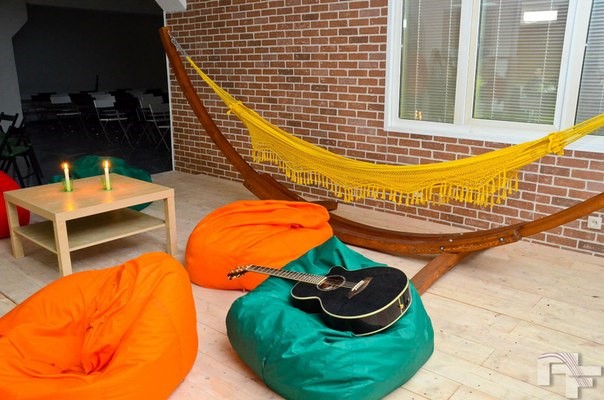
This is how the project, later called “LIFT”, appeared - a business incubator and coworking, which will become a pillar of the hope of IT in Astrakhan, and later will be scaled to other regions. And after talking with David Weekee (David Weekly) and Tim Sias (Tim Sears) from Hacker Dojo (they recently wrote about him here ), their positive experience and the work of the Action Zone (about him here ), it became clear how this whole thing look and work. As in any other project, there are regional features that prompted me to write this post.
Like any other project, a business incubator began with the development of a concept and a business model. All this resulted in a series of hypotheses that we rushed to check.
Naturally, they began with whether coworking was needed in Astrakhan and whether there were any projects for an incubator. We made a rough portrait of a coworking visitor and began to look for these people. They found people, but they didn’t really want to go to co-working: the format was new for them, they didn’t see any special benefits from transferring their “office” from an apartment or cafe to us.
With the projects, as I said, it was also pretty sad (3-4 projects, mostly students without money and team). The fashion for startups has not yet arrived in our city (which may be for the best). Student startups have turned out to be a phenomenon as rare as the appearance of Nessie in the eyes of the general public.

In general, with customers who would have paid for the site and used it, everything was very tight. Since the project is commercial and without public investment, it became sad. There are no startups and communities, because there is no ecosystem, and no ecosystems, because there are no startups and communities. A vicious circle that had to break. For this, I had to swim against the current and incur additional expenses, but I did not want to give up the idea. If not us, then who?
It was easier here, because the project of Astrakhan IT-Park had already started and LIFT ideally fit into its ideology. Therefore, we managed to get a room of 350 sq. M. m. on the first floor, before this place was a furniture store, which left behind a large square area, with rather high ceilings, which with minimal investment could be turned into what the soul wanted.
We quickly prepared a plan for the future premises: a work area, a conference room, a meeting room, a kitchen, toilets, and a recreation area.

In the working area fits 37 stationary places about 180 square meters. The capacity of the conference hall is about 60 people; it must be separated from the working area by a screen so that events can be held there during working hours. Based on the fact that events for 150 people will be held here, it was decided to make 3 toilets at once (during the gathering of system administrators who go with beer, the toilets are very popular).
Recreation area is equipped with a sofa, hammock and drums. There are plans to put some kind of console here, but so far I don’t want to spend money on it (I’m still waiting, maybe someone will give it or bring it), and the additional noise will make it difficult to work.

Up to 12 people can be accommodated in the meeting room, it is popular, despite the echo problem that we already know how to solve, but for now we are looking for carpets with deer.
In the kitchen can eat at the same time 20 people. Almost every zone is equipped with devices for recording thoughts that can suddenly come to mind: from plastic panels in the kitchen, adapted for markers, to a black wall for chalk in a conference room.

Naturally, Wi-Fi is working throughout the territory, everything is as it should be: Internet channel 20 Mbit / s reservation, class N, roaming and everything. Maximum maintained simultaneous connection of 140 users. On the columns in the center of the room is wired Internet for desktops.
Then a long process of design began, which took a lot of time and effort, as a result several options were rejected, the designer was changed during the design, etc. The final version turned out good, but my advice - do not pay so much attention to appearance. Focus on convenience and ergonomics, leave the beauty for later. If we saw Hacker Dojo (not the one that is now, but the one that was) not in February, but earlier, then we would solve the design problem with smaller forces. Now I understand that it was possible to score for redecoration, the atmosphere is created by trifles and people who are not taken into account in the design.
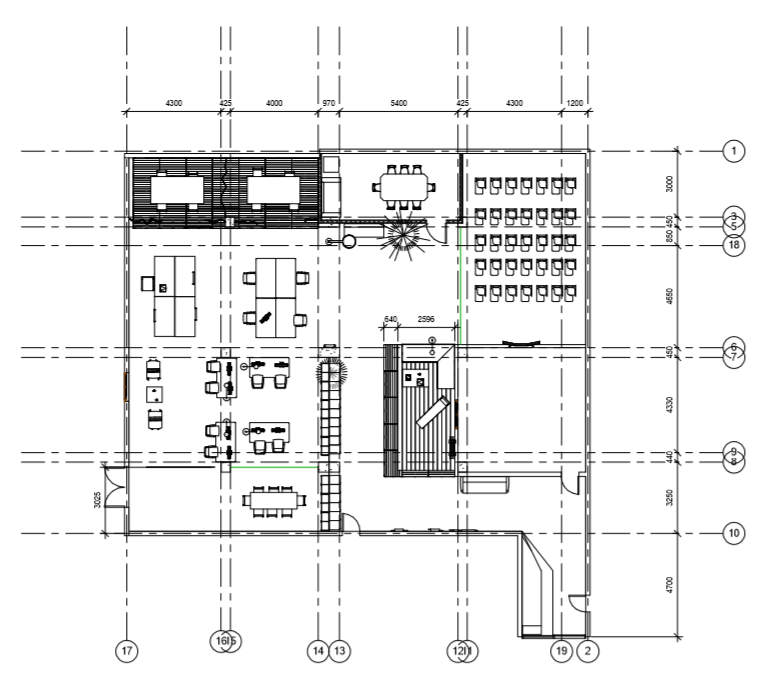
If I had redesigned the premises, now I would not have made the dedicated conference room, since it stands idle most of the time.
Perhaps, we reached the most interesting place. It is too early to talk about income, because the site has just been launched. Now it generates about 200,000 rubles of expenses every month, excluding the salary, since there are no hired employees so far.
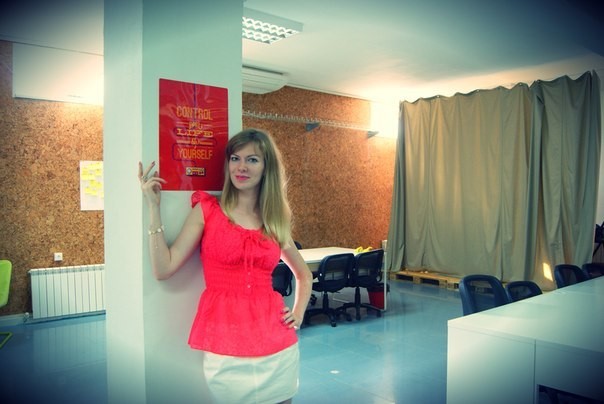
We have such a pricing policy: 3000 rubles per month for a floating workplace, 5000 rubles for a fixed one. Plus, there are hourly rates, you can rent for a while a meeting or a conference room. It is easy to calculate that even at 100% coworking loading by permanent residents, even fixed costs cannot be recouped, not to mention hired employees and incomes.
What to do? We found the answer in educational programs and major events held on our site. According to my calculations, this should bring as much income as coworking. Now thematic events are held here once a week, mostly on weekends, so this hypothesis is likely to be confirmed.
The third source of revenue is sponsorship and partnership. Everything is not obvious here, because so far we have no such practice. There are already partners, however, their support is not monetary, but suddenly. I can’t rule it out, if anyone already has this experience - tell me.
All of the above referred to coworking. As for the business incubator, it is more difficult. Practically all the projects that come to us are not solvent and are looking for money themselves, so for the time being we do not earn money for them. Somewhere we take symbolic money for our services, somewhere we credit until the project receives the money, somewhere we enter the share with an eye to the fact that sometime our investments will return in cash.
Now targeted promotion goes through three channels: word of mouth, events on the site, independent promotion in social networks. Conducting diverse events is the most effective tool, as it automatically brings the necessary media behind it, pulls up the audience from social networks and launches word of mouth.
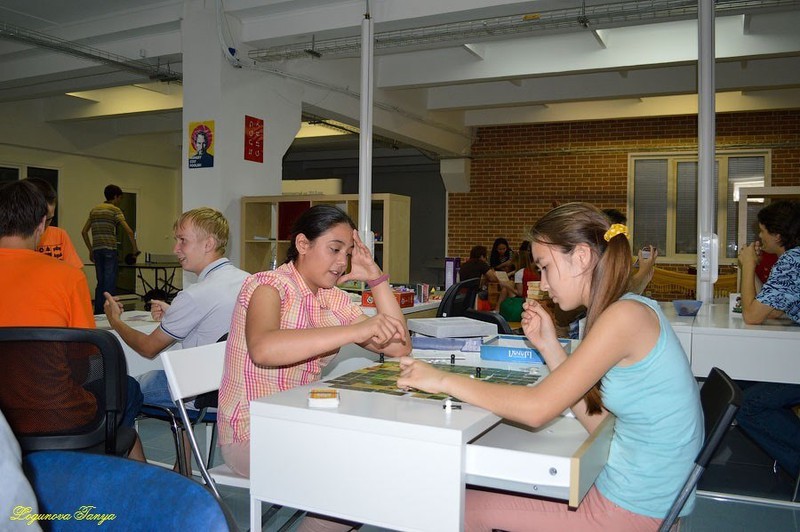
It is important to hold not only thematic events at the site. For example, almost every week we have game stores, intellectual games of the “What? Where? When? ”Was the experience of holding charity events. As a result, if nobody knew about what “LIFT” is, now among the target audience there is the information noise we need, which as a result leads us to those we are looking for.
Strangely enough, the official launch is only on June 14 (if we managed to read before the opening, then I invite you at 16:00!) . At the moment, about a dozen people work in co-working daily with us, there are 4 young start-ups in the incubator (3 more are currently undergoing the selection procedure), 3-4 events are stably taking place every week. After the opening, we start the active phase of work and by the end of July we plan to completely kill coworking, bring the number of incubated projects to 10, and launch several educational programs. July 5-7, we conduct a hackathon; on July 29, we launch a school for start-ups, in late July - regular four-week schools for programmers and mini-schools on programming on specific topics.
We have already passed an express school for young programmers in the Southern Federal District IT-Start, a zone stage of the Microsoft Imagine Cup, a road show of the Russian Startup Tour development institutes (by the way, it was our resident Bravo Motors that won the Startup Village "With the project" e-Trike ") and much more.
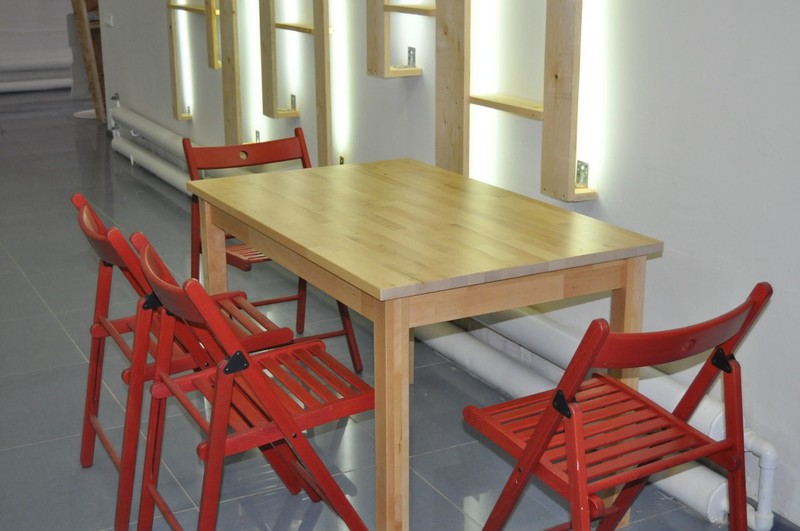
The number of partners and friends helping us reached fifty, recently became Microsoft partners (on the BizSpark program and educational programs), are familiar with almost all the major venture capital funds operating in Russia, and our network of experts includes specialists from around the world, starting from Kazakhstan and ending the Valley. Now we are actively working on educational and acceleration programs and are looking for mentors for projects in the incubator, so if you can help, you are welcome.
And then a giant layer of work. This year we are planning to launch the FabLab rapid prototyping laboratory (last year we failed, but for hardware projects that we really like, such a thing is necessary), to create several success stories from the projects of our residents, to train several hundred programmers , create fifty startups and attract tens of millions for them.
PS Hope it was interesting. As always, I am ready to answer questions in the comments, it will be interesting to receive a return. I will write the next article when everything works in full force, maybe I will talk about projects. What would you like to hear?
PPS The article used photos of the project “AstFutur”, Ivan Rotanov, Roman Shane and other visitors to our site, for which they are very grateful.
Do you remember how it all started?
It all started in a cold and rainy autumn of 2012. At that time, I worked as a project manager at a large IT company and it has been exactly one year since I decided to abandon my web studio and returned to “work for my uncle”. I myself am a programmer by education and went through the chain of “programmer -> team leader -> project manager -> middle manager -> own business”. In the company, I was involved in software development and implementation projects and was in charge of the development of new directions and products (I will continue to use the start-up term because of the shorter term).

Russian Startup Tour (April 2013)
As in any other development company, the staff was sorely lacking. Moreover, both developers and those who could lead them, and with really cool ideas it was tough. Naturally, like any other serious company, we are raising personnel, but this process is not quick and laborious, as a result there are still not enough personnel. To fill this gap, it was decided to follow the path of corporations and start engaging in other people's start-ups, either integrating them into a group of companies, or drawing good people from there, or investing in them with the goal of joining a share (yes, now I have revealed the terrible secret of altruistic companies ).
We decided to start with the Startup Search start-up competition, which was held in October 2012. The competition was very important in terms of the fact that, to my surprise, there were projects and teams that I had never heard of, but, on the other hand, there were very few worthwhile projects. The main reason for this is the lack of a sane ecosystem in our city (and not only in ours, this is a problem of any city-minipolis). There are no professional communities, there are no parties, there are no sensible conferences and educators, good employers can be counted on the fingers. Of course, this was not news, and the idea of creating a professional community and a platform where it could live and develop has long been in the head among cockroaches fighting the storm wind.
')

This is how the project, later called “LIFT”, appeared - a business incubator and coworking, which will become a pillar of the hope of IT in Astrakhan, and later will be scaled to other regions. And after talking with David Weekee (David Weekly) and Tim Sias (Tim Sears) from Hacker Dojo (they recently wrote about him here ), their positive experience and the work of the Action Zone (about him here ), it became clear how this whole thing look and work. As in any other project, there are regional features that prompted me to write this post.
First thing airplanes
Like any other project, a business incubator began with the development of a concept and a business model. All this resulted in a series of hypotheses that we rushed to check.
Customers
Naturally, they began with whether coworking was needed in Astrakhan and whether there were any projects for an incubator. We made a rough portrait of a coworking visitor and began to look for these people. They found people, but they didn’t really want to go to co-working: the format was new for them, they didn’t see any special benefits from transferring their “office” from an apartment or cafe to us.
With the projects, as I said, it was also pretty sad (3-4 projects, mostly students without money and team). The fashion for startups has not yet arrived in our city (which may be for the best). Student startups have turned out to be a phenomenon as rare as the appearance of Nessie in the eyes of the general public.

The bathroom needs your clothes and a motorcycle.
In general, with customers who would have paid for the site and used it, everything was very tight. Since the project is commercial and without public investment, it became sad. There are no startups and communities, because there is no ecosystem, and no ecosystems, because there are no startups and communities. A vicious circle that had to break. For this, I had to swim against the current and incur additional expenses, but I did not want to give up the idea. If not us, then who?
Playground
It was easier here, because the project of Astrakhan IT-Park had already started and LIFT ideally fit into its ideology. Therefore, we managed to get a room of 350 sq. M. m. on the first floor, before this place was a furniture store, which left behind a large square area, with rather high ceilings, which with minimal investment could be turned into what the soul wanted.
We quickly prepared a plan for the future premises: a work area, a conference room, a meeting room, a kitchen, toilets, and a recreation area.

Hammock and drum in the recreation area. They do sometimes sleep here.
In the working area fits 37 stationary places about 180 square meters. The capacity of the conference hall is about 60 people; it must be separated from the working area by a screen so that events can be held there during working hours. Based on the fact that events for 150 people will be held here, it was decided to make 3 toilets at once (during the gathering of system administrators who go with beer, the toilets are very popular).
Recreation area is equipped with a sofa, hammock and drums. There are plans to put some kind of console here, but so far I don’t want to spend money on it (I’m still waiting, maybe someone will give it or bring it), and the additional noise will make it difficult to work.

The room where important negotiations are conducted.
Up to 12 people can be accommodated in the meeting room, it is popular, despite the echo problem that we already know how to solve, but for now we are looking for carpets with deer.
In the kitchen can eat at the same time 20 people. Almost every zone is equipped with devices for recording thoughts that can suddenly come to mind: from plastic panels in the kitchen, adapted for markers, to a black wall for chalk in a conference room.

Conference room with a chalk wall.
Naturally, Wi-Fi is working throughout the territory, everything is as it should be: Internet channel 20 Mbit / s reservation, class N, roaming and everything. Maximum maintained simultaneous connection of 140 users. On the columns in the center of the room is wired Internet for desktops.
Then a long process of design began, which took a lot of time and effort, as a result several options were rejected, the designer was changed during the design, etc. The final version turned out good, but my advice - do not pay so much attention to appearance. Focus on convenience and ergonomics, leave the beauty for later. If we saw Hacker Dojo (not the one that is now, but the one that was) not in February, but earlier, then we would solve the design problem with smaller forces. Now I understand that it was possible to score for redecoration, the atmosphere is created by trifles and people who are not taken into account in the design.

Floor plan
If I had redesigned the premises, now I would not have made the dedicated conference room, since it stands idle most of the time.
Finance
Perhaps, we reached the most interesting place. It is too early to talk about income, because the site has just been launched. Now it generates about 200,000 rubles of expenses every month, excluding the salary, since there are no hired employees so far.

Work area and motivating posters.
We have such a pricing policy: 3000 rubles per month for a floating workplace, 5000 rubles for a fixed one. Plus, there are hourly rates, you can rent for a while a meeting or a conference room. It is easy to calculate that even at 100% coworking loading by permanent residents, even fixed costs cannot be recouped, not to mention hired employees and incomes.
What to do? We found the answer in educational programs and major events held on our site. According to my calculations, this should bring as much income as coworking. Now thematic events are held here once a week, mostly on weekends, so this hypothesis is likely to be confirmed.
The third source of revenue is sponsorship and partnership. Everything is not obvious here, because so far we have no such practice. There are already partners, however, their support is not monetary, but suddenly. I can’t rule it out, if anyone already has this experience - tell me.
All of the above referred to coworking. As for the business incubator, it is more difficult. Practically all the projects that come to us are not solvent and are looking for money themselves, so for the time being we do not earn money for them. Somewhere we take symbolic money for our services, somewhere we credit until the project receives the money, somewhere we enter the share with an eye to the fact that sometime our investments will return in cash.
Promotion
Now targeted promotion goes through three channels: word of mouth, events on the site, independent promotion in social networks. Conducting diverse events is the most effective tool, as it automatically brings the necessary media behind it, pulls up the audience from social networks and launches word of mouth.

One of the traditional games of the weekend.
It is important to hold not only thematic events at the site. For example, almost every week we have game stores, intellectual games of the “What? Where? When? ”Was the experience of holding charity events. As a result, if nobody knew about what “LIFT” is, now among the target audience there is the information noise we need, which as a result leads us to those we are looking for.
What is now and what has been achieved?
Strangely enough, the official launch is only on June 14 (if we managed to read before the opening, then I invite you at 16:00!) . At the moment, about a dozen people work in co-working daily with us, there are 4 young start-ups in the incubator (3 more are currently undergoing the selection procedure), 3-4 events are stably taking place every week. After the opening, we start the active phase of work and by the end of July we plan to completely kill coworking, bring the number of incubated projects to 10, and launch several educational programs. July 5-7, we conduct a hackathon; on July 29, we launch a school for start-ups, in late July - regular four-week schools for programmers and mini-schools on programming on specific topics.
We have already passed an express school for young programmers in the Southern Federal District IT-Start, a zone stage of the Microsoft Imagine Cup, a road show of the Russian Startup Tour development institutes (by the way, it was our resident Bravo Motors that won the Startup Village "With the project" e-Trike ") and much more.

A slice of the kitchen. Almost all the furniture is from Ikea.
The number of partners and friends helping us reached fifty, recently became Microsoft partners (on the BizSpark program and educational programs), are familiar with almost all the major venture capital funds operating in Russia, and our network of experts includes specialists from around the world, starting from Kazakhstan and ending the Valley. Now we are actively working on educational and acceleration programs and are looking for mentors for projects in the incubator, so if you can help, you are welcome.
What's next?
And then a giant layer of work. This year we are planning to launch the FabLab rapid prototyping laboratory (last year we failed, but for hardware projects that we really like, such a thing is necessary), to create several success stories from the projects of our residents, to train several hundred programmers , create fifty startups and attract tens of millions for them.
PS Hope it was interesting. As always, I am ready to answer questions in the comments, it will be interesting to receive a return. I will write the next article when everything works in full force, maybe I will talk about projects. What would you like to hear?
PPS The article used photos of the project “AstFutur”, Ivan Rotanov, Roman Shane and other visitors to our site, for which they are very grateful.
Source: https://habr.com/ru/post/183254/
All Articles